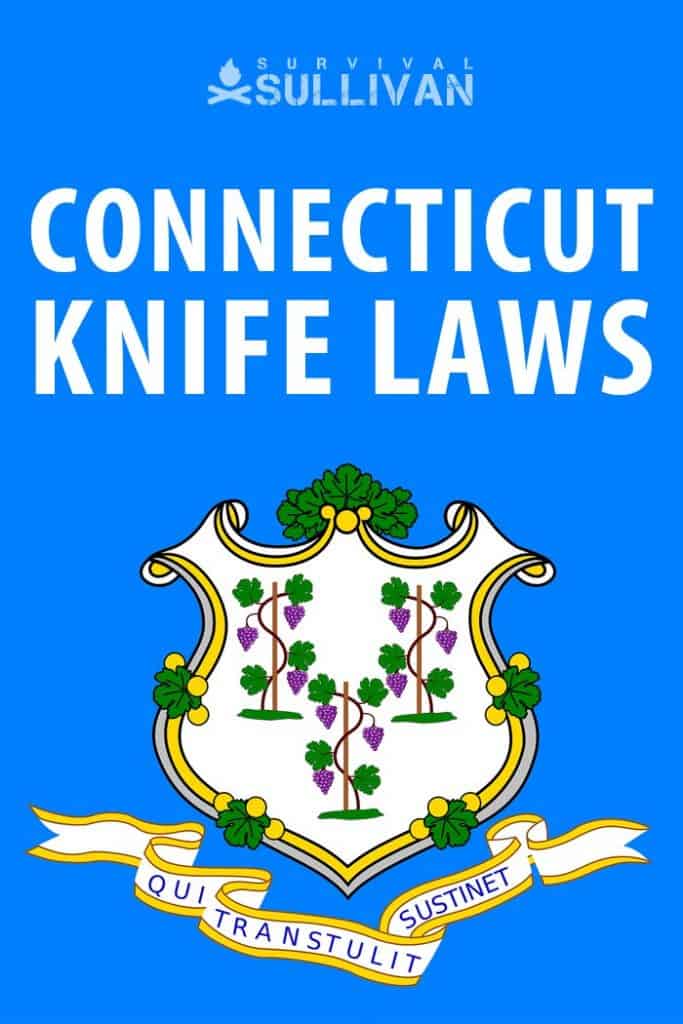- Legal to Open Carry:
- Any non-switchblade with a blade of 4” or less
- Any switchblade with a blade of 1 ½” or less
- Legal to Carry Concealed
- Any non-switchblade with a blade of 4” or less
- Any switchblade with a blade of 1 ½” or less
- Note: Assisted opening knives likely fit definition of switchblade under current statutes. See below.

Connecticut Knife Law Overview
Connecticut is another surprisingly permissive state by the standards of the New England region.
There are no explicitly banned knives, only a blanket ban on carrying concealed any knife with a blade over 4” and a darn-near total ban on switchblades by way of regulating any concealed carry switchblade to one with a blade of 1 ½” or less.
You will have to deal with changes, sometimes significant changes, in knife laws thanks to a lack of preemption, also. There are though thankfully few other major locations restricted from carry aside from the usual schools and government buildings.
The rest of Connecticut’s laws are straightforward and easy to understand for the most part, and the state is otherwise hampered only by a lack of statewide preemption. We’ll crack open the Connecticut State Statutes and have at look at what they say below.
Relevant Connecticut State Statutes Covering Use and Ownership of Knives
- Connecticut State Constitution, Article 1 Section 15
- 53-206 Carry of dangerous weapons
Connecticut, despite their yellow-bellied treatment of gun owners’ property rights concerning assault weapons, does indeed, believe it or not, have its own affirmation of citizens’ right to keep and bear arms in the State Constitution. See Article 1, Section 15 below:
“Every citizen has a right to bear arms in defense of himself and the State.”
Yeah, except, you know, the scary evil ones! Presumably this covers knives as well. Pretty much the entirety of Connecticut’s knife laws are contained within 53-206, which describes prohibited types and lengths of knives for both open and concealed carry:
Section 53-206 – Carrying of dangerous weapons prohibited.
(a) Any person who carries upon his or her person any BB. gun, blackjack, metal or brass knuckles, or any dirk knife, or any switch knife, or any knife having an automatic spring release device by which a blade is released from the handle, having a blade of over one and one-half inches in length, or stiletto, or any knife the edged portion of the blade of which is four inches or more in length, any police baton or nightstick, or any martial arts weapon or electronic defense weapon, as defined in section 53a-3, or any other dangerous or deadly weapon or instrument, shall be guilty of a class E felony.
Whenever any person is found guilty of a violation of this section, any weapon or other instrument within the provisions of this section, found upon the body of such person, shall be forfeited to the municipality wherein such person was apprehended, notwithstanding any failure of the judgment of conviction to expressly impose such forfeiture.
(b) The provisions of this section shall not apply to (1) any officer charged with the preservation of the public peace while engaged in the pursuit of such officer’s official duties; (2) the carrying of a baton or nightstick by a security guard while engaged in the pursuit of such guard’s official duties;
(3) the carrying of a knife, the edged portion of the blade of which is four inches or more in length, by
(A) any member of the armed forces of the United States, as defined in section 27-103, or any reserve component thereof, or of the armed forces of the state, as defined in section 27-2, when on duty or going to or from duty,
(B) any member of any military organization when on parade or when going to or from any place of assembly,
(C) any person while transporting such knife as merchandise or for display at an authorized gun or knife show,
(D) any person who is found with any such knife concealed upon one’s person while lawfully removing such person’s household goods or effects from one place to another, or from one residence to another,
(E) any person while actually and peaceably engaged in carrying any such knife from such person’s place of abode or business to a place or person where or by whom such knife is to be repaired, or while actually and peaceably returning to such person’s place of abode or business with such knife after the same has been repaired,
(F) any person holding a valid hunting, fishing or trapping license issued pursuant to chapter 490 or any saltwater fisherman carrying such knife for lawful hunting, fishing or trapping activities, or
(G) any person while participating in an authorized historic reenactment; (4) the carrying by any person enrolled in or currently attending, or an instructor at, a martial arts school of a martial arts weapon while in a class or at an authorized event or competition or while transporting such weapon to or from such class, event or competition; (5) the carrying of a BB. gun by any person taking part in a supervised event or competition of the Boy Scouts of America or the Girl Scouts of America or in any other authorized event or competition while taking part in such event or competition or while transporting such weapon to or from such event or competition; and (6) the carrying of a BB. gun by any person upon such person’s own property or the property of another person provided such other person has authorized the carrying of such weapon on such property, and the transporting of such weapon to or from such property.
…
Connecticut’s law is clear cut: you may have on or about your person no switchblade with a blade measuring more than 1 ½” or any other kind of knife with a blade measuring longer than 4”. There are no other restrictions. To violate the above statute is a felony.
The language defining switchblades and related knives- “any knife having an automatic spring release device by which a blade is released from the handle” does in all probability include assisted opening knives as well as more usual automatics.
To my knowledge there has been no test case involving such knives in CT and you do not want to be the first. Stick to conventional folders or fixed blades for your daily carry option.
Also of interest is Connecticut’s precise use of “edged portion of the blade” which is certainly distinct from the overall length of the blade of a knife as many knives have at least a small portion of the blade that is not sharpened for whatever reason.
However, it is certainly possible that the common meaning of “edge” may be the narrow surface on either ling side of the blade, not necessarily a sharpened portion or part capable of cutting.
Do not get tricky or technical with any measurements on any knife you choose to carry in CT; make sure the blade is at least an 1/8” and preferably a quarter-inch shorter than the stated maximum length as measured from any portion of the handle. Take no chances!
Wait, are Assisted Opening Knives Legal or Not?
That’s a good question. Yes, they are legal, but since the statute describing restricted knives, specifically reads “any knife having an automatic spring release device by which a blade is released from the handle,” we can safely lump them in with switchblades.
Now, some of you will no doubt start to lawyer the language used.
You will construe the passage as meaning a locking device, release or some other mechanism that keeps the blade stowed in the handle until it is actuated, and that the thumbstud, flipper, nick or whatever that assists you in opening the knife is hereto forthwith vis-a-vis not a switchblade!
So, ergo, you can carry your assisted opening knife in confidence.
Not. So. Fast. If you aren’t a lawyer, sit this one out, chief. There are all kinds of legal precepts used to interpret laws as they are written.
Then you have prosecutorial and judges opinions. Then all of that gets filtered and constrained (sometimes) by case law and precedent set by like cases with similar or identical violations.
There is no hard and fast on most laws like this. Suffice it to say, the intent of the law, as written, is clear enough, and you’d be a fool to violate it, or at least do so flagrantly without advice from your attorney. And he had better be competent.
You see, CT’s statutory law is also lacking the increasingly popular “bias toward closure” language that specifically helps to insulate assisted opening and related knives (a class of action distinctly different from true automatics or “switchblades”) from regulation intended to affect automatic knives, there is essentially no distinction, as written, between the two in the eyes of the law.
Now, a competent attorney may well be able to wow and bamboozle the judge and/or jury that you assisted opening knife is not a switchblade, can’t be a switchblade and you are an innocent man, and should be acquitted. A competent, expensive attorney might pull that off, yes.
Do you have a competent attorney? Can you afford the services of one? If the answer is “no” then you would be best served by keeping your assisted opener, switchblade and other spring-powered blades significantly below the proscribed minimum blade length of 1 ½”.
No-Go Zones
Schools, state legislature buildings, public hearings and meetings. Guns and dangerous weapons are prohibited in CT schools, including pocket knives. Guns also fall under federal mandates on school zones, so take care to leave you weapons at home if you have to head into or onto school property.
Public meetings, voting locations, local and state legislature and governmental buildings’ status are heavily influenced by local laws covering knives and weapons. Make sure you check municipal and city laws thoroughly!
Preemption
None. There is no statewide preemption for knives in Connecticut. Several major cities have their own prohibitions covering knives you’ll need to learn if you want to make sure you are staying on the safe and un-incarcerated side of the law.
Restrictions on action, mode of carry, blade length and more may become factors in your selection process for a “daily driver” knife.
Remember: ignorance is never a defense against the law, especially as it pertains to weapons offenses!
Bottom Line
Connecticut is middle of the road for knife carry and ownership as far as typically-oppressive New England states are concerned.
A stiff switchblade restriction and overall length restriction is balmed somewhat by otherwise easy to follow laws and few restrictions on type or style of knife you are allowed to carry.
If you are cautious with where you carry, learn local laws and stick to “all-ok” styles and lengths of knives you should not have much trouble in CT.


Tom Marlowe practically grew up with a gun in his hand, and has held all kinds of jobs in the gun industry: range safety, sales, instruction and consulting, Tom has the experience to help civilian shooters figure out what will work best for them.

Blade length on fixed blade not the issue per se, edged portion of the blade must be under 4 inches. Blade length could be longer.
I am still confused. Can you carry a gravity knife with an edge less than 4” in public?